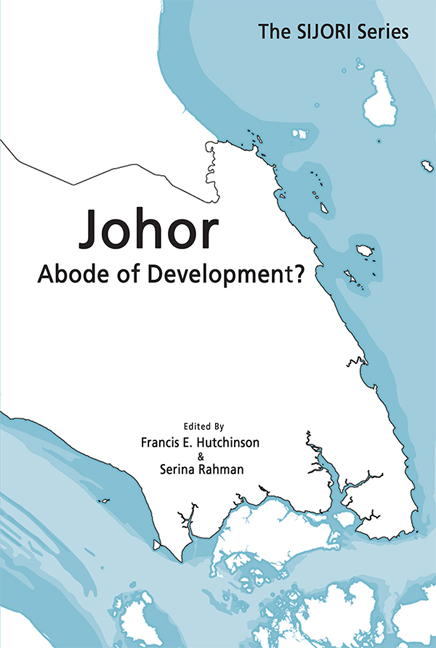19 - Johor: Abode of Development?
Published online by Cambridge University Press: 24 November 2020
Summary
INTRODUCTION
This volume has evaluated myriad aspects of Johor's current reality, setting out many of the key issues facing Peninsular Malaysia's southernmost state. It has illustrated in maps and words the workings of different sectors of Johor's economy, its unique political context, and the myriad social and environmental challenges it is facing.
This publication is the second in a series that focuses on the Singapore-Johor- Riau Islands or SIJORI Cross-Border Region (CBR). Unlike the first of the series, The SIJORI Cross-Border Region: Transnational Politics, Economics, and Culture, which takes Singapore as the anchor-point for the geo-economic entity, this volume on Johor and the third volume on the Riau Islands focus on the other two territories in the Cross-Border Region. They explore how these territories are influenced by their belonging to a larger political entity—Malaysia and Indonesia, respectively—yet are also shaped by their connections to their neighbouring territories.
While analysis on the SIJORI CBR may tend to be overly shaped by Singapore's influence, so, too, work on Malaysia and Indonesia can focus overmuch on the Klang Valley and Java, respectively. Consequently, these two tomes also seek to redress the geographic imbalance in the study of these two countries by deepening our knowledge of two economically vital but physically non-central territories.
One key date that both Johor and the Riau Islands share is 1990, when both territories sought to market their economies through the Growth Triangle, comprised of these two entities plus Singapore. The benefits of this partnership have been deep and far-reaching, as the economies of both the Malaysian and Indonesian territories underwent structural change on the back of heightened investment flows and the construction of cross-border production networks (Hutchinson 2015).
With this as a backdrop, the guiding questions for these two books are:
• Is the manufacture for export model put in place by Johor and the Riau Islands still valid, and what effect have measures to catalyse new sectors had?
• What have been the political, social, and environmental impacts on these territories of the rapid economic development set in motion since the early 1990s?
• How are these two territories evolving in response to developments within their respective countries on one hand, and the SIJORI Cross-Border Region on the other?
- Type
- Chapter
- Information
- JohorAbode of Development?, pp. 504 - 516Publisher: ISEAS–Yusof Ishak InstitutePrint publication year: 2020



